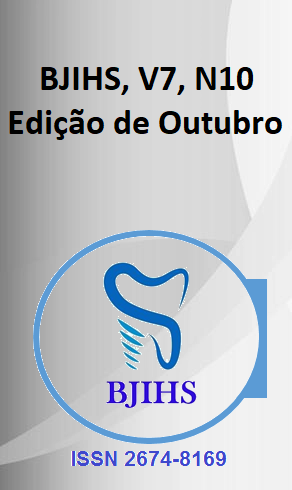Abstract
Introduction: Bisphosphonate-associated osteonecrosis of the jaws is a rare but potentially severe complication related to the use of antiresorptive drugs. This condition represents a growing challenge for dental practice due to its negative impact on patients’ quality of life and the limitations it imposes on surgical interventions. Although knowledge about bisphosphonate-associated osteonecrosis of the jaws has advanced, controversies remain regarding early diagnosis and the most effective therapeutic strategies. Objective: To analyze the factors related to the prevention and management of osteonecrosis of the jaws in patients using bisphosphonates who undergo invasive dental procedures, identifying risks, preventive strategies, treatment protocols, and gaps for future research. Methodology: This study is an integrative literature review conducted in the databases SciELO, PubMed, Virtual Health Library (VHL), and Google Scholar, including articles in Portuguese, English, and Spanish published over the last 20 years. Descriptors such as “osteonecrosis of the jaws,” “bisphosphonates,” “dental surgery,” “prevention,” and “management” were used, combined with Boolean operators. In total, 18 studies met the inclusion criteria and were critically analyzed. Results: Prevention was mainly focused on prior dental evaluation before starting drug therapy, elimination of infectious foci, and maintenance of strict oral hygiene. Risk factors included duration of bisphosphonate use, route of administration, comorbidities, poorly fitted prostheses, and polypharmacy. Conservative clinical protocols involving antibiotics, analgesics, and antiseptics proved effective in the early stages. In advanced stages, surgical treatment combined with adjuvant therapies such as laser therapy, ozone therapy, and teriparatide use demonstrated promising but still heterogeneous results. Conclusion: The implementation of preventive strategies, early diagnosis, and treatment choice according to clinical staging are fundamental to reducing the incidence and severity of osteonecrosis of the jaws. Integration between medical and dental teams is essential to improve patient prognosis. Further longitudinal studies and clinical trials are required to standardize approaches and validate emerging therapies.
References
Aiex LS, Jimenez MVJ; Milena AP. Osteonecrose mandibular relacionada com bifosfonatos orais em paciente idosa polimedicada. Revista Brasileira de Medicina de Família e Comunidade. 2015; 10(36): 1-7; Rio de Janeiro.
Badros A et al. Natural History of Osteonecrosis of the Jaw in Patients With Multiple Myeloma. American Society of Clinical Oncology. Journal of Clinical Oncology. 2008; 26(36): 5904-5909
Borjaille BP. et al. Osteonecrose e Síndrome da Imunodeficiência Adquirida. Revista Brasileira de Reumatologia. 2006; 46(1): 36-44; São Paulo.
Bortolini MP. Bifosfonatos na Odontologia. 2009; 42f. Trabalho de Conclusão de Curso em Especialização em Implantodontia. 2009; Universidade Tuiuti do Paraná.
Bortolon PC. Envelhecimento e osteoporose senil: descrição do atendimento hospitalar para fratura de fêmur no SUS. 66f. Dissertação. 2010. Fundação Oswaldo Cruz, Rio de Janeiro.
Brozoski MA et al. Osteonecrose maxilar associada ao uso de bisfosfonatos. Revista Brasileira de Reumatologia. 2012. 52(2): 260- 270; São Paulo.
Consolaro A, Consolaro MF. Os bifosfonatos e o tratamento ortodôntico: análise criteriosa e conhecimento prévio são necessários. Revista Dental Press de Ortodontia e Ortopedia Facial. 2008; 13(4): p. 19-25.
Costa MS et al. O uso de bifosfonatos e sua relação com a odontogeriatria. Congresso Nacional de Envelhecimento Humano. 2016; Universidade Estadual da Paraíba. Natal.
Crossetti MO. Revisão integrativa de pesquisa na enfermagem: o rigor científico que lhe é exigido [editorial]. Revista Gaúcha de Enfermagem. 2012; 33(2):8-9.
Ferreira GE et al. Uso de bifosfonatos em idosos: complicações e condutas em odontologia. Revista Intercâmbio. 2017; X: 137-153.
Forte ACCB, Frascino AVM. Interação dos Bisfosfonatos na Cirurgia Odontológica. Atas de Ciências da Saúde. 2016; 4(1): 12-22; São Paulo.
Gregori C, Campos AC. Cirurgia Buco-dento-alveolar. 2. Ed. Rev. e Ampl. São Paulo; SARVIER, 2004.
Izquierdo CM, Oliveira MG, Weber, JBB. Terapêutica com bisfosfonatos: implicações no paciente odontológico - Revisão de Literatura. Revista da Faculdade de Odontologia. 2011; 16(3): 347-352; Passo Fundo.
Jesus AP et al. Tratamento cirúrgico para osteonecrose dos maxilares induzida por bisfosfonatos: relatos de casos. RFO UPF. 2019; 24(1): p. 22-30.
Loures MAR et al. Diretrizes da Sociedade Brasileira de Reumatologia para diagnóstico e tratamento da osteoporose em homens. Revista Brasileira de Reumatologia. 2017; 57(S2): S497–S514; São Paulo.
Marx RE. Pamidronate (Aredia) and zoledronate (Zometa) induced avascular necrosis of the jaws: A growing epidemic. Journal of Oral and Maxillofacial Surgery. 2003; 61: 1115.
Mehrotra B, Ruggiero SL. Bisphosphonate complications including osteonecrosis of the jaw. American Society of Hematology., 2006; :.356-60.
Milani CM et al. Osteonecrose mandibular associada ao uso de bifosfonato: relato de caso. Odonto.2012; 20(39): 27-33.
Neto T, Gouveia H. Osteonecrose dos Maxilares Associada ao uso de Bifosfonatos (OMAB) – Artigo de Revisão. Revista da Associação dos Médicos Estomatologistas Portugueses. 2012.; :12-15.
Oermann MF. In: Toronto CE, Remington R, editors. A Step-by-Step Guide to Conducting an Integrative Review. Springer Nature Switzerland AG; 2020. 106 p.
Pedrosa CMMF. Osteonecrose dos Maxilares Associada aos Bifosfonatos. 2010. 15f. Dissertação (Mestrado Integrado em Medicina) - Instituto de Ciências Biomédicas Abel Salazar, Universidade do Porto. Lisboa.
Ruggiero SL, Fantasia J, Carlson E. Bisphosphonate- related osteonecrosis of the jaw: background and guidelines for diagnosis, staging and management. Oral Surgery, Oral Medicine, Oral Pathology, Oral Radiology, and Endodontology.2006; 102(4): 433-441.
Ruggiero SL et al. American Association of Oral and Maxillofacial Surgeons Position Paper on Medication-Related Osteonecrosis of the Jaw—2014 Update. Journal of Oral and Maxillofacial Surgery. 2014; 72(10): 1938-1956.
Santos CC, Pimenta CADM, Nobre MRC. A estratégia PICO para a construção da pergunta de pesquisa e busca de evidências. Revista Latino-americana de Enfermagem. 2007;15(3): 508-511.
Silva TSG et al. Avaliação odontológica prévia ao uso de drogas antirreabsortivas para prevenção da osteonecrose dos maxilares em pacientes com osteoporose. REAS. 2024; 24(10).
Torraco, RJ. Writing Integrative Reviews of the Literature: Methods and Purposes. Human Resource Development Review, 4(3): 356–367.
Vilela-Carvalho LN, Tuany-Duarte N, Andrade-Figueiredo M, López-Ortega k. Osteonecrosis de los maxilares relacionados con el uso de medicamentos: Diagnóstico, tratamiento y prevención. Rev. CES Odont 2018; 31(2): 48-63.

This work is licensed under a Creative Commons Attribution 4.0 International License.
Copyright (c) 2025 Christopher Oliveira, Samara Gonçalves de Faria, Camilla Chiesa, Caio Junji Tanaka, Alberto Martins de Jesus, Valter Toshimitsu Sakaguchi

